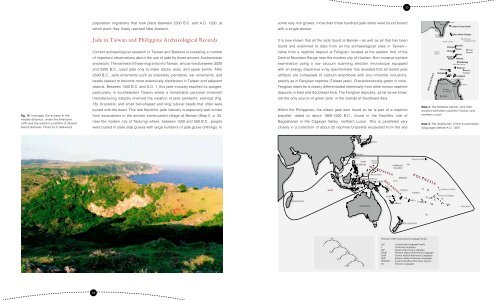Jade and the Philippines
Jade and the Philippines
Jade and the Philippines
You also want an ePaper? Increase the reach of your titles
YUMPU automatically turns print PDFs into web optimized ePapers that Google loves.
Fig. 19. Torongan Cave (seen in <strong>the</strong><br />
middle distance, under <strong>the</strong> limestone<br />
cliff) <strong>and</strong> <strong>the</strong> eastern coastline of Itbayat<br />
Isl<strong>and</strong>, Batanes. Photo by P. Bellwood<br />
population migrations that took place between 2500 B.C. <strong>and</strong> A.D. 1200, at<br />
which point <strong>the</strong>y finally reached New Zeal<strong>and</strong>.<br />
<strong>Jade</strong> in Taiwan <strong>and</strong> Philippine Archaeological Records<br />
Current archaeological research in Taiwan <strong>and</strong> Batanes is revealing a number<br />
of important observations about <strong>the</strong> use of jade by <strong>the</strong>se ancient Austronesian<br />
ancestors. The earliest of <strong>the</strong>se migrants into Taiwan, who arrived between 3500<br />
<strong>and</strong> 2500 B.C., used jade only to make adzes, axes, <strong>and</strong> spear points. After<br />
2500 B.C., jade ornaments such as bracelets, pendants, ear ornaments, <strong>and</strong><br />
beads started to become more extensively distributed in Taiwan <strong>and</strong> adjacent<br />
isl<strong>and</strong>s. Between 1500 B.C. <strong>and</strong> A.D. 1, this jade industry reached its apogee,<br />
particularly in sou<strong>the</strong>astern Taiwan where a remarkable personal ornament<br />
manufacturing industry involved <strong>the</strong> creation of jade pendants, earrings (Fig.<br />
18), bracelets, <strong>and</strong> small bell-shaped <strong>and</strong> long tubular beads that often were<br />
buried with <strong>the</strong> dead. This late Neolithic jade industry is especially well-known<br />
from excavations in <strong>the</strong> ancient stone-paved village at Beinan (Map 2, p. 35,<br />
near <strong>the</strong> modern city of Taidong) where, between 1500 <strong>and</strong> 500 B.C., people<br />
were buried in slate slab graves with large numbers of jade grave offerings. In<br />
34<br />
some very rich graves, more than three hundred jade items were found buried<br />
with a single person.<br />
It is now known that all <strong>the</strong> jade found at Beinan—as well as all that has been<br />
found <strong>and</strong> examined to date from all <strong>the</strong> archaeological sites in Taiwan—<br />
came from a nephrite deposit at Fengtian, located at <strong>the</strong> eastern foot of <strong>the</strong><br />
Central Mountain Range near <strong>the</strong> modern city of Hualian. Non-invasive surface<br />
examination using a low vacuum scanning electron microscope equipped<br />
with an energy dispersive x-ray spectrometer has revealed that all tested jade<br />
artifacts are composed of calcium amphibole with zinc-chromite inclusions,<br />
exactly as in Fengtian nephrite (Taiwan jade). Characteristically green in color,<br />
Fengtian nephrite is clearly differentiated chemically from o<strong>the</strong>r known nephrite<br />
deposits in East <strong>and</strong> Sou<strong>the</strong>ast Asia. The Fengtian deposits, as far as we know,<br />
are <strong>the</strong> only source of green jade in <strong>the</strong> isl<strong>and</strong>s of Sou<strong>the</strong>ast Asia.<br />
Within <strong>the</strong> <strong>Philippines</strong>, <strong>the</strong> oldest jade item found so far is part of a nephrite<br />
bracelet, dated to about 1800-1500 B.C., found in <strong>the</strong> Neolithic site of<br />
Nagsabaran in <strong>the</strong> Cagayan Valley, nor<strong>the</strong>rn Luzon. This is paralleled very<br />
closely in a collection of about 25 nephrite bracelets excavated from <strong>the</strong> site<br />
MADAGASCAR<br />
WMP<br />
AN<br />
F MP<br />
TAIWAN<br />
F<br />
Lan-yu<br />
Hainan<br />
WMP<br />
VIET NAM<br />
PHILIPPINES<br />
• KOREA<br />
• JAPAN<br />
MICRONESIA<br />
PALAU<br />
Caroline Isl<strong>and</strong>s<br />
Halmahera<br />
MALAYSIA<br />
Borneo<br />
SHWNG PAPUA<br />
Sulawesi<br />
NEW GUINEA<br />
Serath<br />
CMP<br />
Timor<br />
INDONESIA<br />
WMP CEMP<br />
CMP EMP<br />
CMP Oc<br />
AUSTRALIA<br />
Mariana<br />
Isl<strong>and</strong>s<br />
MARSHALL<br />
ISLANDS<br />
MELANESIA<br />
Solomon Is<br />
VANUATU<br />
New Caledonia<br />
35<br />
KIRIBATI<br />
Nauru<br />
TUVALU<br />
Oc<br />
FIJI<br />
TONGA<br />
• NEW ZEALAND<br />
Hawaiian Isl<strong>and</strong>s<br />
Map 3. The distribution of <strong>the</strong> Austronesian<br />
languages before A.D. 1500<br />
POLYNESIA<br />
SAMOA<br />
Cook Isl<strong>and</strong>s<br />
Structure of <strong>the</strong> Austronesian Language Family<br />
Oc<br />
Tahiti<br />
AN Austronesian Language Family<br />
F Formosan Languages<br />
MP Malayo-Polynesian Languages<br />
WMP Western Malayo-Polynesian Languages<br />
CMP Central Malayo-Polynesian Languages<br />
EMP Eastern Malayo-Polynesian Languages<br />
SHWNG South Halmahera West New Guinea<br />
Oc Oceanic Languages<br />
• Tainan<br />
Beinan •<br />
• Shanyuan<br />
Fengbitou •<br />
Ludao (Green Isl<strong>and</strong>)<br />
PHILIPPINES<br />
Kending •<br />
Oluanbi<br />
Bashi Channel<br />
Luzon<br />
strait<br />
Mavolis<br />
Misanga<br />
Siayan<br />
Itbayat<br />
Batan<br />
Dequey<br />
Batanes<br />
IsL<strong>and</strong>s<br />
Ibuhos Sabtang<br />
Balintang<br />
Calayan<br />
Balintang channel<br />
Babuyan<br />
BaBuyan<br />
Dalupiri<br />
Fuga<br />
IsL<strong>and</strong>s<br />
Camiguin<br />
Babuyan Channel<br />
• Paoay Lake<br />
• Nagsabaran & Irigayen<br />
• Magapit<br />
Pamittan •<br />
& Andarayan<br />
L u z o n<br />
Cagayan Valley<br />
Marquesas Isl<strong>and</strong>s<br />
Tuamotu Archipelago<br />
Lanyu (Botel Tobago)<br />
200 meter<br />
submergence line<br />
Map 2. The Batanes Isl<strong>and</strong>s, <strong>and</strong> <strong>the</strong>ir<br />
location between sou<strong>the</strong>rn Taiwan <strong>and</strong><br />
nor<strong>the</strong>rn Luzon<br />
•<br />
Easter Isl<strong>and</strong>


